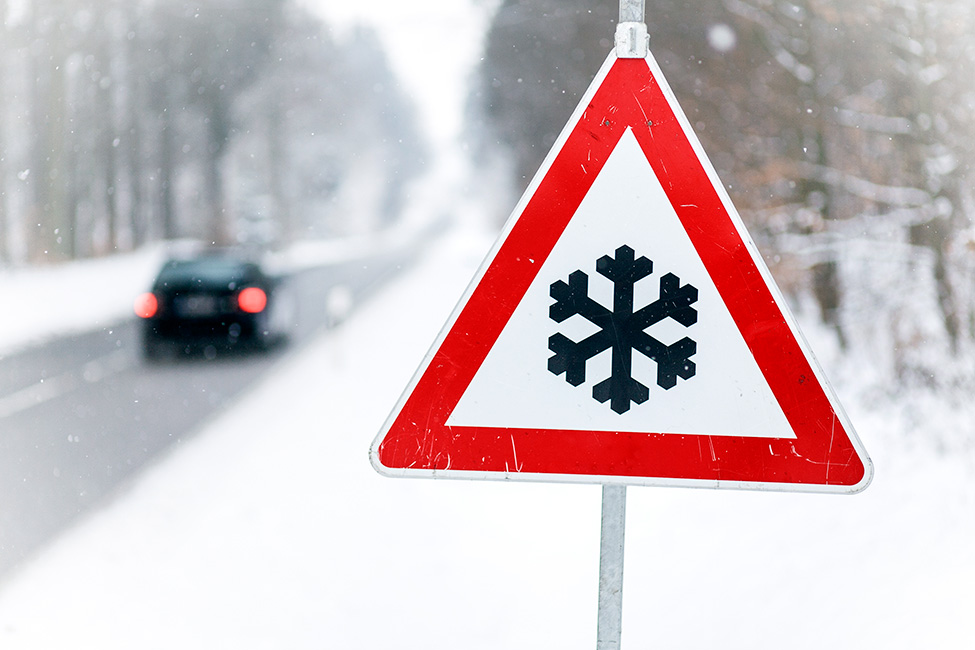How to drive on snow and ice?
How to drive on snow and ice?

©ollo/iStock
The hazards of winter weather can give road users a hard time. What can you do to maintain control of your vehicle and avoid skidding in icy and snowy conditions? Here are some tips to help you drive safely on icy or snowy roads.<br />
How do you recognise ice on the road?
Unlike snow, which is visible as soon as the first flakes fall, ice is more difficult to spot, especially at night. Here are some pointers to help you anticipate the presence of black ice on the road:
- It usually appears in the morning or at nightfall;
- It reflects the sun’s rays during the day;
- It occurs mainly in shady areas and near forests or undergrowth;
- It is often found on bridges and in damp places.
Be prepared when travelling in the event of snow or ice
As winter approaches, a few preventive measures will enable you to drive more safely. For example, it is advisable to opt for winter tyres as soon as the temperature drops below 7° C. These provide a better grip on ice and snow-covered roads. Always check weather information before you start your journey. If possible, postpone your journey in the event of snow, ice or a warning of extreme cold. Choosing an alternative route may also help you to avoid the most dangerous areas.
Keeping your vehicle in good working order is one of the most important safety measures you can take. When you visit the garage, have your vehicle checked, in particular the brakes and steering. Before setting off, remember to clear and de-ice your windscreen to ensure optimum visibility.
Be prepared: carry a charged telephone, a blanket, a bottle of water or thermos, as well as a snack in case your vehicle becomes immobilised.
How can you adapt your driving to accommodate icy or snowy conditions?
On snowy or icy roads, it is advisable to maintain a longer gap than you usually would between other vehicles. It will give you more time to brake or stop if the vehicle in front of you happens to skid out of control. Avoid using the cruise control function and drive smoothly at a modest speed under the limit.
Good to know: at a speed of 30 mph, it can take up to 10 times longer for your vehicle to stop on black ice and up to 4 times longer on snow versus a dry road. That means you need to leave up to 10 times more space in between you and other vehicles on the road.
What should you do if your vehicle gets into trouble on snow or ice?
Snow or ice on the road can cause two particular problems: skidding and slipping.
In case of skidding
Skidding leads to the loss of vehicle control. If you are skidding with a rear-wheel driving vehicle, avoid using the brakes. Braking will cause the wheels to lock and will prevent you from being able to control the vehicle. Steer in the same direction as the rear of the vehicle is sliding towards. For example, if the rear of your vehicle is slipping to the left side, then turn your steering wheel to the left and vice versa. Hold onto your steering wheel firmly until you establish a good grip on a dry stretch of road.
Good to know: If you have a front-wheel driving vehicle, it is better to slightly disengage the clutch and brake to reduce your speed.
In case of slipping or getting stuck
If your wheels start to slip due to excessive snow or ice, begin with switching off the traction control system on the dashboard. With the car in the lowest gear, gently press the accelerator while keeping your wheels straight. If the vehicle is still stuck, you can try the following techniques:
- Use a shovel to manually clear the snow from around the wheels;
- Have someone push the vehicle forward or pull it back while you press down on the accelerator;
- Turn your front-driving wheels in either direction;
- Position mats under the wheels to improve the driving grip;
- Sprinkle some sand, salt or cat litter in front of the wheels;
- Temporarily deflate your tyres by a slight amount (only if you can quickly inflate them again afterwards).
Requirements for automatic gearboxes
Some vehicles with automatic gearboxes will have a driving mode for snow, which is very helpful to avoid skidding when taking off.
While driving, if your tyres slip, switch the gear to N (neutral) to cut the link between the engine and your wheels. Ensure to wait until you have a good grip on the road before switching the gear back to D (drive) mode.
On snowy or icy roads and regardless of what kind of vehicle you are driving, you must always exercise caution. Adapting your driving style and exercising best practices to correctly respond to these conditions will minimise the risk of accidents.
Feel like getting away from it all?
See our suggestions for novel trips and must-see places to visit near your home or holiday destination.